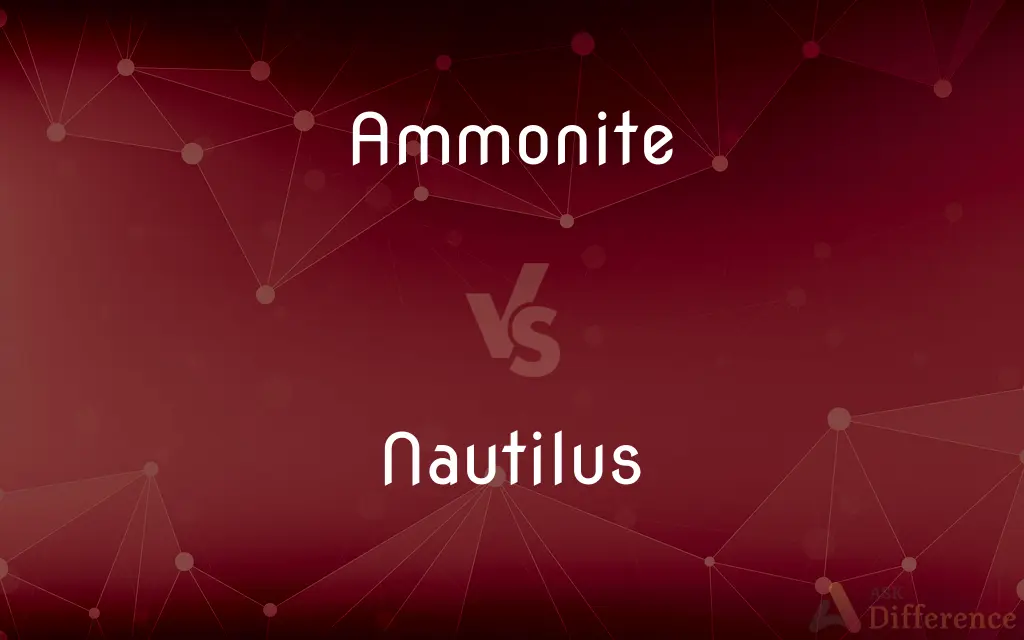Ammonite vs. Nautilus — What's the Difference?
Edited by Tayyaba Rehman — By Fiza Rafique — Updated on September 30, 2023
"Ammonite" refers to extinct marine mollusks with spiral shells, while "Nautilus" is a modern marine cephalopod with a similar shell. Both have chambered shells, but only the nautilus is alive today.

Difference Between Ammonite and Nautilus
Table of Contents
ADVERTISEMENT
Key Differences
"Ammonite" denotes a group of extinct marine mollusks that thrived during the Jurassic and Cretaceous periods. These creatures are recognized for their iconic, coiled, and often ornate shells. In contrast, "Nautilus" identifies a contemporary marine cephalopod, and while it bears a shell similar in shape to the ammonite, it represents an entirely different lineage.
In the realm of paleontology, "Ammonite" fossils are commonly found and serve as critical index fossils, helping scientists date other organisms in the same sediment layer. On the other hand, "Nautilus", being a living organism, plays its role in today's marine ecosystem, offering insight into cephalopod evolution and behavior.
While both the "Ammonite" and "Nautilus" have chambered shells, the patterns and details found on ammonite shells are diverse and often intricate. Conversely, the shell of a "Nautilus" exhibits a more consistent and simpler pattern, highlighting the distinct evolutionary paths these creatures have taken.
Comparison Chart
Classification
Extinct marine mollusks
Living marine cephalopods
Existence
Thrived during Jurassic and Cretaceous periods
Exists today
ADVERTISEMENT
Use in Science
Index fossils for dating sediment layers
Offers insights into cephalopod evolution
Shell Pattern
Diverse and often intricate patterns
Simpler, more consistent pattern
Historical Significance
Related to the Egyptian god Ammon; used in jewelry and art
Subject of art, poetry, and literature; symbolizes sea mysteries
Compare with Definitions
Ammonite
Creatures with ornate and varied shell patterns.
The intricate designs on the ammonite shell captivated the museum-goers.
Nautilus
An inhabitant of deep-sea tropical waters.
The nautilus prefers the deeper, darker parts of the ocean.
Ammonite
Marine organisms from the Jurassic and Cretaceous periods.
The ammonite thrived when dinosaurs roamed the Earth.
Nautilus
A modern marine cephalopod with a coiled shell.
The nautilus is one of the few cephalopods with an external shell.
Ammonite
Extinct marine mollusks with coiled shells.
The fossilized ammonite was a treasured find at the dig site.
Nautilus
A symbol of the mysteries of the sea in literature.
Holmes' poem paints the nautilus as an emblem of life's journey.
Ammonite
A symbol of ancient or lost worlds in literature.
The author used the ammonite to evoke a sense of a bygone era.
Nautilus
A creature known for its chambered shell structure.
As it grows, the nautilus adds more chambers to its shell.
Ammonite
A fossil used as an index in paleontology.
Scientists utilized the ammonite to date the surrounding rocks.
Nautilus
The nautilus (from the Latin form of the original Ancient Greek: ναυτίλος, 'sailor') is a pelagic marine mollusc of the cephalopod family Nautilidae. The nautilus is the sole extant family of the superfamily Nautilaceae and of its smaller but near equal suborder, Nautilina.
Ammonite
A member of a Semitic people inhabiting ancient Ammon, mentioned frequently in the Bible.
Nautilus
Any of several cephalopod mollusks of the family Nautilidae of the Indian and Pacific Oceans, especially Nautilus pompilius, having numerous slender tentacles and an external coiled pearly shell divided into air-filled chambers. Also called chambered nautilus, pearly nautilus.
Ammonite
The Semitic language of the Ammonites.
Nautilus
The paper nautilus.
Ammonite
An extinct cephalopod mollusk of the order Ammonitida of the Permian to Cretaceous Periods, having a thick, usually coiled shell characterized by intricate suture patterns where the septa between individual chambers join the outer shell wall.
Nautilus
A marine mollusc, of the family Nautilidae native to the Pacific Ocean and Indian Ocean, which has tentacles and a spiral shell with a series of air-filled chambers, of which Nautilus is the type genus.
Ammonite
An ammonoid.
Nautilus
A kind of diving bell that sinks or rises by means of compressed air.
Ammonite
(paleontology) Any of an extinct group of cephalopods of the subclass Ammonoidea; a fossil shell of such an animal.
Nautilus
The only existing genus of tetrabranchiate cephalopods. About four species are found living in the tropical Pacific, but many other species are found fossil. The shell is spiral, symmetrical, and chambered, or divided into several cavities by simple curved partitions, which are traversed and connected together by a continuous and nearly central tube or siphuncle. See Tetrabranchiata.
Ammonite
An explosive prepared from a mixture of TNT and ammonium nitrate; a form of amatol, popular in Eastern Europe and China.
Nautilus
The argonaut; - also called paper nautilus. See Argonauta, and Paper nautilus, under Paper.
Ammonite
A fossil cephalopod shell related to the nautilus. There are many genera and species, and all are extinct, the typical forms having existed only in the Mesozoic age, when they were exceedingly numerous. They differ from the nautili in having the margins of the septa very much lobed or plaited, and the siphuncle dorsal. Also called serpent stone, snake stone, and cornu Ammonis.
Nautilus
A variety of diving bell, the lateral as well as vertical motions of which are controlled, by the occupants.
Ammonite
One of the coiled chambered fossil shells of extinct mollusks
Nautilus
A submarine that is propelled by nuclear power
Nautilus
Cephalopod mollusk of warm seas whose females have delicate papery spiral shells
Nautilus
Cephalopod of the Indian and Pacific oceans having a spiral shell with pale pearly partitions
Nautilus
A living link to ancient marine organisms.
The nautilus provides insights into the evolution of marine life.
Common Curiosities
Do they both have coiled shells?
Yes, both "Ammonite" and "Nautilus" have coiled, chambered shells.
Are "Ammonite" and "Nautilus" the same creature?
No, "Ammonite" is an extinct mollusk, while "Nautilus" is a living cephalopod.
Why are "Ammonite" fossils important in paleontology?
They serve as index fossils, helping date other organisms in sediment layers.
Do humans use "Ammonite" shells for anything today?
Yes, they are often used in jewelry, art, and as collector's items.
Is the "Nautilus" an ancient creature?
While it has ancient origins, the "Nautilus" species we see today are modern.
Where can you find a "Nautilus" today?
In deep-sea tropical waters.
Did "Ammonite" and "Nautilus" ever coexist?
Yes, they overlapped for millions of years, but only the "Nautilus" survives today.
Which one is extinct?
The "Ammonite" is extinct.
What's the origin of the name "Ammonite"?
It derives from the Egyptian god Ammon, as they resembled his ram horns.
What does a "Nautilus" symbolize in literature?
It often symbolizes growth, evolution, and the mysteries of the sea.
Which one is linked to dinosaurs in terms of the time frame?
The "Ammonite", as they lived during the Jurassic and Cretaceous periods.
Are "Ammonite" shells diverse in design?
Yes, they have varied and often intricate patterns.
Why is the "Nautilus" shell chambered?
The chambers help with buoyancy and grow as the creature matures.
Can we see a living "Ammonite" today?
No, "Ammonites" went extinct around 66 million years ago.
Is the "Nautilus" the only cephalopod with a shell?
No, but it's one of the few with a prominent external shell.
Share Your Discovery

Previous Comparison
Long vs. Length
Next Comparison
Bear vs. BruinAuthor Spotlight
Written by
Fiza RafiqueFiza Rafique is a skilled content writer at AskDifference.com, where she meticulously refines and enhances written pieces. Drawing from her vast editorial expertise, Fiza ensures clarity, accuracy, and precision in every article. Passionate about language, she continually seeks to elevate the quality of content for readers worldwide.
Edited by
Tayyaba RehmanTayyaba Rehman is a distinguished writer, currently serving as a primary contributor to askdifference.com. As a researcher in semantics and etymology, Tayyaba's passion for the complexity of languages and their distinctions has found a perfect home on the platform. Tayyaba delves into the intricacies of language, distinguishing between commonly confused words and phrases, thereby providing clarity for readers worldwide.














































